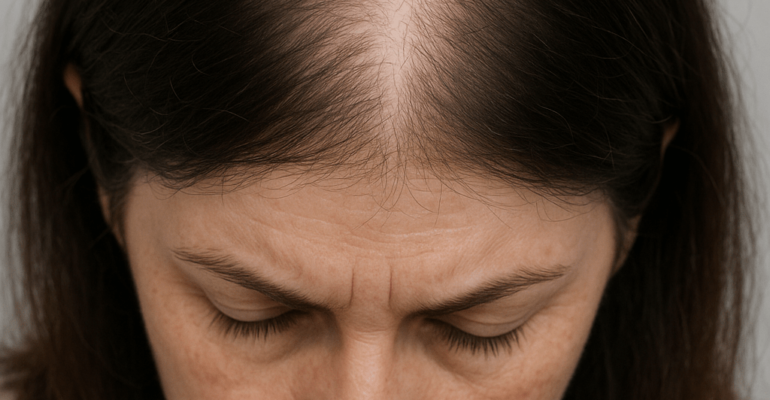Hair Loss in Females: Causes, Types & Treatments
April 25, 2025 2025-04-25 11:07Hair Loss in Females: Causes, Types & Treatments
As an Amazon associate, Dermatocare earns from valid purchase made by clicking on the affiliate links in this blog.

Hair Loss in Females: Causes, Types & Treatments
Hair loss in women is a growing concern, affecting not just the scalp but also self-confidence and emotional well-being. Unlike men, where hair loss typically follows a defined pattern, women often experience diffuse thinning or excessive shedding, which can be harder to diagnose and manage without medical expertise.
In this article, we will explore the types of female hair loss, how to distinguish between them, the common causes, treatment options, and how to design a dermatologist-recommended hair regrowth regime tailored for women.
Types of Hair Loss in Women
Hair loss in females is broadly categorized into two major types:
1. Telogen Effluvium (TE)
This is a reactive hair loss that occurs when a large number of hair follicles prematurely enter the telogen (resting) phase of the hair cycle. It presents as diffuse shedding across the entire scalp and is usually temporary if the underlying cause is corrected.
2. Female Pattern Hair Loss (FPHL)

Also known as Androgenetic Alopecia in women, this is a genetically driven, progressive thinning of hair, mainly affecting the crown and central scalp, while usually sparing the frontal hairline. Unlike TE, it does not cause overt shedding but rather gradual reduction in hair volume and density.
How to Distinguish Between Telogen Effluvium and Female Pattern Hair Loss
| Feature | Telogen Effluvium (TE) | Female Pattern Hair Loss (FPHL) |
|---|---|---|
| Onset | Sudden, often within 2–3 months of a trigger | Gradual, over years |
| Shedding | Noticeable shedding (on pillow, comb, shower drain) | Minimal visible shedding |
| Scalp Visibility | Even thinning, no bald patches | Increased scalp visibility over crown or parting line |
| Hair Density | Overall reduction in density | Specific thinning at crown and midline |
| Miniaturization | Absent | Present (detected via trichoscopy) |
| Reversibility | Reversible when cause is treated | Progressive without treatment |
Common Causes of Hair Loss in Females
Understanding the cause is crucial in determining the correct treatment. The following are common causes, categorized based on the hair loss type they are more commonly associated with:
Causes of Telogen Effluvium:
- Postpartum period
- Acute illness or high fever (e.g., COVID-19, typhoid)
- Surgery or trauma
- Crash dieting or protein deficiency
- Iron, Vitamin D, or Zinc deficiency
- Mental stress, grief, or anxiety
- Thyroid dysfunction (hypo or hyperthyroidism)
- Certain medications (antidepressants, anticoagulants, etc.)
Causes of Female Pattern Hair Loss:
- Genetic predisposition (often runs in maternal family)
- Hormonal imbalances such as:
- Polycystic Ovary Syndrome (PCOS)
- Increased androgens (male hormones)
- Menopause-related estrogen decline
- Chronic inflammation or microvascular issues of the scalp
- Prolonged use of hairstyles causing tension (traction alopecia)
Treatment Options for Hair Loss in Females
Treatment must be tailored according to the type and cause of hair loss. Below is a breakdown of therapeutic options based on diagnosis:
Treatment for Telogen Effluvium:
- Address Underlying Cause
E.g., correct iron, zinc or vitamin D deficiencies, manage thyroid dysfunction, and reduce stress. - Nutritional Supplements
Oral biotin, amino acids, iron, vitamin D3, zinc, and omega-3 fatty acids. - Topical Minoxidil (2% or 5%)
May be used temporarily to accelerate regrowth, especially in chronic TE. - Low-Level Laser Therapy (LLLT)
Safe, non-invasive tool to stimulate follicular activity. - Platelet-Rich Plasma (PRP)
In select cases of chronic TE with miniaturization, PRP may be considered to support follicular regeneration.
Treatment for Female Pattern Hair Loss:
- Topical Minoxidil (FDA-approved)
2% twice daily or 5% once daily can help increase hair density by prolonging the anagen phase. - Oral Anti-Androgens
- Spironolactone: Inhibits androgen activity at the follicle level.
- Oral contraceptives: For women with PCOS or hormonal imbalance.
- Oral Finasteride (off-label in females)
Used cautiously in postmenopausal women under dermatologic supervision. - Microneedling or PRP
Helps stimulate collagen production and increase growth factor delivery to miniaturized follicles. - Hair Transplantation
For advanced cases with stable hair loss and sufficient donor area.
Hair Regrowth Regime for Females
A consistent, targeted routine is key to managing hair loss and promoting regrowth. Here is a basic dermatologist-approved hair care regime:
Step 1: Scalp Preparation & Cleansing
- Use a sulfate-free, pH-balanced shampoo 2–3 times a week.
- Choose shampoos with caffeine, biotin, ketoconazole or salicylic acid depending on scalp condition.
Step 2: Scalp Topical Treatment
- Apply Minoxidil 2% or 5% on dry scalp once daily (at night preferably).
- Leave on overnight without rinsing.
Step 3: Nutritional Support
- Daily intake of iron, zinc, vitamin D, and biotin-based supplements.
- Protein-rich diet with eggs, lentils, tofu, paneer, leafy greens, and seeds.
Step 4: Weekly Scalp Stimulation
- Microneedling (home rollers) under dermatologist guidance once a week.
- Scalp massage with natural oils like rosemary, pumpkin seed, or argan oil.
Step 5: Medical Review Every 3–6 Months
- Monitor improvement and modify regimen based on trichoscopy and lab markers.
Step 6: Long-Term Maintenance
- Continue minoxidil or oral therapy for at least 6–12 months to assess true benefit.
- Understand that hair regrowth is gradual and may take 3–6 months to show visible results.
Conclusion
Hair loss in women can stem from multiple causes, and the treatment must be precise, personalized, and consistent. Distinguishing between telogen effluvium and female pattern hair loss is essential to avoid unnecessary treatments and expectations.
If you are unsure of the type or cause of your hair loss, or if your current treatment isn’t showing results, use the Dermatocare Regime Finder Tool to receive a personalized, dermatologist-designed hair regrowth routine that suits your scalp condition, hair loss type, and lifestyle.
ROUTINE FINDER
Get free dermatologist-recommended regime by choosing your skin or concerns.

FACE

HAIRS

CHILD

BODY




